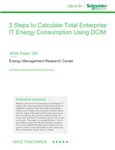As of 2022, over half of all corporate data resides in the cloud, meaning demand for cloud storage has never been higher. Like a falling domino, this has triggered severe energy consumption throughout the data center industry, resulting in substantial greenhouse gas (GHG) emissions.
Disturbingly, the European Commission estimates that by 2030, EU data center energy use will increase from 2.7 percent to 3.2 percent of the Union's total demand. This would put the industry’s emissions almost neck and neck with pollution from the EU’s international aviation.
Yet, it must be remembered that cloud storage is still far more sustainable than the alternatives.
Why is cloud storage more sustainable?
It’s crucial to put the energy used by cloud storage into context and consider the savings it can make elsewhere. Thanks to sharing services and file storage, teams can collaborate and work wherever they are, removing the need for large offices and everyday commuting.
This means businesses can downsize their workspaces as well as reduce the environmental impact caused by employees traveling. In fact, it’s estimated that working from home four days a week can reduce nitrogen dioxide emissions by around 10 percent.
Besides this, cloud storage reduces dependence on physical, on-premises servers. For small and medium-sized businesses (SMBs), having on-site servers or their own data centers can be expensive, whilst running and cooling the equipment requires a lot of energy, which means more CO2 emissions.
Cloud servers, on the other hand, offer a more efficient alternative. Unlike on-premises servers that might only be used to a fraction of their capacity, cloud servers in data centers can be used much more effectively. They often operate at much higher capacities, thanks to virtualization technology that allows a single physical server to act as multiple virtual ones.
Each virtual server can be used by different businesses, meaning fewer physical units are needed overall. This means less energy is required to power and cool, leading to a reduction in overall emissions.
In addition, on-premises servers often have higher storage and computing capacity than needed just to handle occasional spikes in demand, which is an inefficient use of resources. Cloud data centers, by contrast, combine large amounts of equipment to manage these spikes more efficiently.
In 2022, the average power usage effectiveness of data centers improved. This indicates that cloud providers are using energy more efficiently and helping companies reduce their carbon footprint with cloud storage.
A sustainable switch: three steps to create green cloud storage
Importantly, there are ways to further improve the sustainability of services like cloud storage, which could translate to energy savings of 30-50 percent through greening strategies. So, how can businesses make the sustainable transition from normal cloud storage to green cloud storage? Well, we believe there are three fundamental steps.
Firstly, businesses should consider location. This means picking a cloud storage provider that’s close to a power facility. This is because distance matters. If electricity travels a long way between generation and use, a percentage is lost. In addition, data centers located in underwater environments or cooler climates can reduce the energy required for cooling.
Next, businesses should ask green providers about what they’re doing to minimize their environmental impact. For example, powering their operations with solar, wind, or biofuels reduces reliance on fossil fuels and so lowers GHG emissions. Some facilities will house large battery banks to store renewable energy and ensure a continuous, eco-friendly power supply.
Last but certainly not least, technology offers a powerful avenue for enhancing the energy efficiency of cloud storage. Some providers have been investing in algorithms, software, and hardware designed to optimize energy use. For instance, introducing AI and machine learning algorithms or frequency scaling can drastically improve how data centers manage power consumption and cooling.
This is illustrated by Google’s use of its DeepMind AI that reduced its data center cooling bill by 40 percent – a prime example of how intelligent systems can contribute towards greater sustainability.
With the world warming up at an accelerating rate, selecting a cloud storage provider that demonstrates a clear commitment to sustainability can have a significant impact. In fact, major cloud providers like Google, Microsoft, and Amazon have already taken steps to make their cloud services greener, such as by pledging to move to 100 percent renewable sources of energy.
Cloud storage that doesn’t cost the Earth
Undeniably, the cloud is reshaping the nature of business as we know it, but this digital growth risks an unpredictable future with serious environmental consequences. But businesses shouldn’t have to choose between the Earth and innovation.
Instead, it’s a balancing act. And the answer lies in green cloud storage. By choosing providers powered by renewable energy, efficient data centers, and innovative technologies, businesses can reap the rewards of the cloud without incurring a harmful energy penalty on the planet.
There’s no time to waste. We must act now. Businesses have an obligation to choose green cloud storage and be part of the solution, not the problem. By making the switch today, we can ensure the cloud remains a convenient sanctuary, not a climate change culprit.








